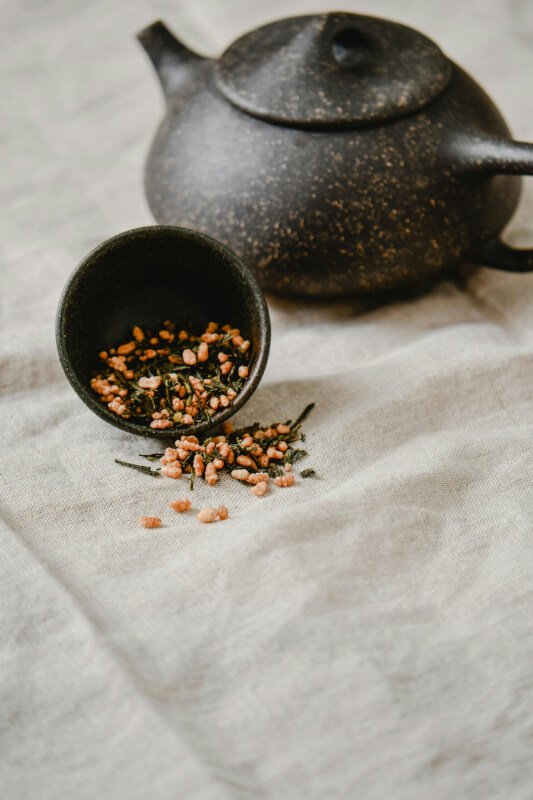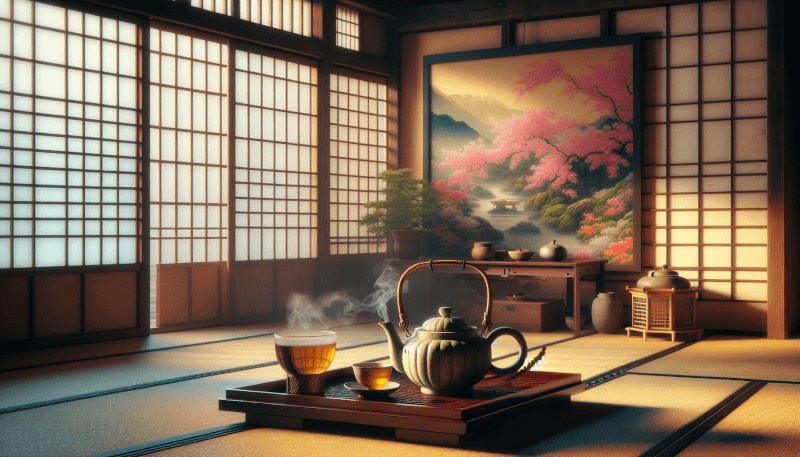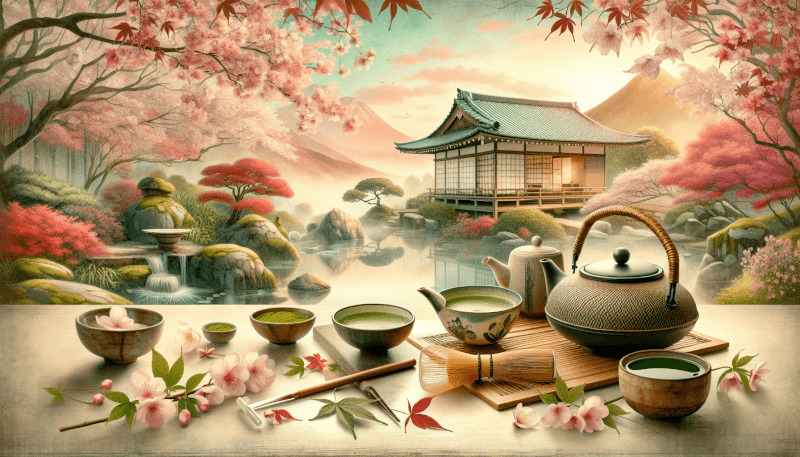Imagine immersing yourself in the serene world of Japanese tea brewing, where calmness and precision converge. With every sip, you are transported to the lush green tea fields of Japan, experiencing the delicate flavors and centuries-old traditions in each cup. In this article, you will embark on a journey to master the art of Japanese tea brewing. From understanding the different types of tea to perfecting the brewing techniques, you will discover the secrets to creating a harmonious and authentic tea-drinking experience. Get ready to elevate your tea rituals and savor the tranquility that comes with every aromatic infusion.

Choosing the Right Tea Leaves
When it comes to Japanese tea brewing, choosing the right tea leaves is essential. With a rich history and cultural significance, Japanese tea offers a wide range of flavors and aromas to explore. Understanding the different varieties available is the first step in selecting the perfect tea leaves for your brewing experience.
Understanding the Different Varieties
Japanese tea is known for its variety, ranging from delicate green teas to robust matcha. Each variety has its own unique characteristics and brewing methods. Sencha, for example, is a popular variety known for its grassy flavor and vibrant green color. Genmaicha, on the other hand, is a blend of green tea leaves and roasted brown rice, resulting in a nutty and fragrant brew. By familiarizing yourself with the different types of Japanese tea, you can choose the ones that best suit your taste preferences.
Selecting High-Quality Leaves
To ensure a satisfying tea brewing experience, it’s important to choose high-quality tea leaves. Look for leaves that have been carefully harvested, processed, and stored to maintain their freshness and flavor. Opt for tea leaves that are vibrant in color, with a pleasant aroma. When purchasing tea, it’s advisable to buy from trusted sources that specialize in Japanese tea to ensure authenticity and quality.
Considering Flavor Profiles
Japanese tea offers a diverse range of flavor profiles, from vegetal and grassy to earthy and floral. Consider the flavor notes you enjoy in a tea and select varieties that align with your preferences. If you enjoy a refreshing and grassy taste, sencha or gyokuro may be ideal choices. For those who prefer a milder and slightly sweet flavor, hojicha or genmaicha could be more suitable. Experimenting with different flavors and varieties will allow you to discover your personal favorites.
Understanding the Japanese Tea Ceremony
The Japanese tea ceremony, also known as “chado” or “sado,” is a cultural practice that embodies harmony, respect, and tranquility. Rooted in history and tradition, this ceremonial art form allows participants to experience a deep connection with tea, nature, and themselves. Understanding the history, etiquette, and rituals of the Japanese tea ceremony is key to fully appreciating the beauty and significance of this ancient practice.
Exploring the History and Tradition
The Japanese tea ceremony has its roots in Zen Buddhism and dates back to the 9th century. It was initially introduced by Buddhist monks who brought tea seeds from China. Over time, the ceremony evolved into a distinct Japanese practice, focusing on mindfulness and the appreciation of tea. Exploring the history and tradition behind the tea ceremony not only deepens your knowledge but also enhances your overall tea brewing experience.
Learning the Etiquette and Rituals
The Japanese tea ceremony is guided by a set of etiquette and rituals, creating a sense of harmony and respect among participants. Learning these rituals, such as how to properly hold a teacup or how to bow when receiving tea, allows you to fully immerse yourself in the ceremony. Attention to detail and a mindful approach are crucial in mastering the etiquette, ensuring a seamless and authentic experience.
Embracing the Zen Philosophy
At the heart of the Japanese tea ceremony is the Zen philosophy, which emphasizes mindfulness, simplicity, and tranquility. Embracing this philosophy while brewing tea can create a meditative and serene environment. The tea ceremony invites you to slow down, appreciate the present moment, and find inner peace through the act of brewing and savoring tea. By incorporating the Zen philosophy into your tea brewing practice, you can enhance your connection with the tea and cultivate a sense of calmness in your daily life.
Required Equipment for Tea Brewing
To brew Japanese tea in the traditional manner, there are several essential tools and utensils that you will need. These tools enhance the brewing experience and contribute to the overall aesthetic and ambiance of the tea ceremony.
Teapot or Kyusu
A teapot, or “kyusu” in Japanese, is a key tool for brewing Japanese tea. It is typically made from clay or porcelain and is designed to enhance the flavors and aromas of the tea. The shape and size of the teapot can vary depending on the type of tea being brewed.
Tea Cups or Chawan
Tea cups, or “chawan,” are an integral part of the tea brewing process. They come in various shapes and sizes, each serving a specific purpose. The cups are designed to showcase the color and clarity of the tea, as well as provide a pleasant drinking experience.
Tea Strainer or Chashaku
A tea strainer, or “chashaku,” is used to prevent tea leaves from being poured into the tea cup. It is a small bamboo spoon-like utensil that allows for precise and controlled pouring of tea.
Tea Scoop or Thermometer
A tea scoop, or “chashaku,” is used to measure and transfer tea leaves from the container to the teapot. It ensures the correct amount of tea is used for brewing. Alternatively, a thermometer can be used to monitor the water temperature, ensuring optimal brewing conditions.
Water Kettle or Mizusashi
A water kettle, or “mizusashi,” is used to heat water to the appropriate temperature for brewing Japanese tea. It is important to select a kettle that allows for precise temperature control to achieve the best flavor extraction from the tea leaves.
Preparing the Teaware
Before brewing Japanese tea, it is essential to properly prepare and care for the teaware. This includes cleaning and warming the teapot, warming the tea cups, and arranging the tea utensils.
Cleaning and Warming the Teapot
Before each use, it is important to clean the teapot thoroughly to remove any residue or impurities. This can be done by rinsing the teapot with hot water or using a soft cloth to wipe the interior. Additionally, warming the teapot with hot water helps to create an optimal brewing environment and enhances the flavors of the tea.
Warming the Cups
Similar to the teapot, warming the tea cups with hot water ensures that the brewed tea maintains its temperature for a longer period. It also enhances the aroma and flavor of the tea. Rinse the cups with hot water or place them in a bowl filled with warm water for a few minutes before use.
Arranging the Tea Utensils
As part of the tea ceremony, arranging the tea utensils in a specific manner adds to the aesthetic appeal and attention to detail. Each utensil has its designated place and should be arranged accordingly. This careful arrangement creates a sense of harmony and adds to the overall visual experience of the tea brewing process.

Measuring the Tea Leaves
Accurately measuring the tea leaves is crucial for achieving the desired strength and flavor in your brew. Both the amount of tea leaves used and the tea-to-water ratio play a significant role in influencing the taste of the final cup.
Determining the Right Amount
The amount of tea leaves to use varies depending on the type of tea and personal preference. Generally, it is recommended to use around one teaspoon of tea leaves per cup (approximately 200ml) of water. However, for stronger or milder brews, the amount can be adjusted accordingly.
Understanding the Tea-to-Water Ratio
The tea-to-water ratio affects the concentration and strength of the tea. It is typically recommended to use one teaspoon of tea leaves for every 200ml of water, but this can be adjusted to taste. For a stronger brew, more tea leaves can be used, while for a milder brew, fewer tea leaves are appropriate. Experimenting with different ratios will allow you to find the perfect balance for your taste preferences.
Heating the Water
The temperature of the water used for brewing Japanese tea significantly impacts the flavor and aroma of the final brew. Different types of tea require specific water temperatures to achieve the best results.
Choosing the Right Water Temperature
Green teas, such as sencha or gyokuro, are usually brewed with water around 70-80°C (158-176°F). The delicate nature of these teas allows for lower water temperatures to avoid bitterness. However, for roasted teas like hojicha or genmaicha, hotter water at around 90°C (194°F) is recommended to extract the flavors fully. It is important to follow the recommended water temperature for each tea variety to achieve optimal taste.
Boiling and Cooling Techniques
To achieve the desired water temperature for brewing, one can use different techniques. Boiling water and then allowing it to cool for a few minutes is a common method to reach the desired temperature range. Alternatively, using a thermometer can help monitor the water temperature accurately. Experiment with different techniques to find the method that works best for you and allows for consistent brewing.

Steeping the Tea Leaves
The process of steeping tea involves allowing the tea leaves to infuse in hot water for a specific period. This step is critical in achieving the desired flavor profile of the tea.
Mastering the Proper Steeping Time
The optimal steeping time varies depending on the type of tea and personal preference. For green teas, the recommended steeping time is usually around 1-2 minutes. However, some teas may require shorter or longer steeping times. It is advisable to follow the instructions provided with the tea or experiment to find the perfect balance of flavor and strength.
Understanding the Different Steeping Methods
Japanese tea can be steeped using various methods, including the traditional “senchado” method or the simpler “hojicha teapot” method. Each method offers a unique brewing experience and allows for different flavor profiles to emerge. Experimenting with different steeping methods can help you discover the one that resonates with you and produces the best brew.
Pouring and Serving the Tea
The manner in which tea is poured and served greatly contributes to the overall experience and enjoyment. Proper pouring techniques, presentation to guests, and serving tea accompaniments all play a role in creating a memorable tea brewing experience.
Pouring Techniques
When pouring tea, it is important to do so with elegance and precision. Hold the teapot steadily and pour the tea smoothly, avoiding any spills or splashes. A controlled pour allows for an even distribution of tea, ensuring that each cup receives its fair share of the brew. Practice pouring techniques to master the art of graceful tea service.
Presenting the Tea to Guests
In the Japanese tea ceremony, the act of presenting tea to guests is a thoughtful and respectful gesture. Offer the tea cup with both hands, ensuring that the design of the cup faces the guest. This small gesture demonstrates your appreciation and creates a sense of harmony and connection with your guests.
Serving Tea Accompaniments
In addition to the tea itself, serving tea accompaniments adds an extra layer of enjoyment to the tea brewing experience. Traditional Japanese sweets, known as “wagashi,” are often served alongside tea to complement the flavors and provide a balance of sweetness. Carefully selecting and presenting these accompaniments enhances the overall experience and allows for a harmonious pairing of flavors.

Appreciating the Aroma and Flavor
The aroma and flavor of Japanese tea are integral aspects that make the brewing experience truly enjoyable. Taking the time to appreciate and analyze these elements adds depth and richness to your tea brewing journey.
Inhaling the Fragrance
Before taking a sip, inhale the aroma of the tea. The fragrance can give you insights into the flavors and nuances that await. Pay attention to the notes of grass, flowers, or roasted elements that may be present in the scent. Taking a moment to appreciate the enchanting fragrance adds to the sensory experience of the tea.
Tasting the Tea
When savoring Japanese tea, take small sips and allow the flavors to coat your palate. Let the tea linger in your mouth, experiencing the subtle changes and complexities as it evolves. Notice the sweetness, bitterness, umami, or floral characteristics that unfold with each sip. By slowly savoring the tea, you can fully immerse yourself in its flavors and appreciate its intricacies.
Identifying Flavor Notes and Nuances
As you explore different varieties and brewing methods, you will begin to identify distinct flavor notes and nuances in Japanese tea. Some teas may have hints of seaweed or chestnut, while others may possess a delicate floral undertone. Developing your ability to discern these flavors not only enhances your tea-tasting skills but also deepens your connection with the tea itself. Take time to reflect on these flavor profiles and expand your sensory appreciation.
Experimenting with Tea Variations
While tradition plays a significant role in Japanese tea brewing, there is also room for creativity and experimentation. Embrace your personal preferences and explore different tea variations to make the brewing process truly your own.
Exploring Different Tea Blends
Japanese tea blends offer a fusion of flavors and aromas, combining different varieties to create unique taste profiles. Blend sencha with matcha for a vibrant and energizing brew, or experiment with combining roasted teas and floral varieties for a more complex flavor experience. The possibilities are endless, and by exploring different blends, you can discover your own signature cup of tea.
Adding Ingredients for Flavor Enhancements
For those seeking an extra layer of flavor, consider adding ingredients to your brewed tea. Fresh ginger, citrus slices, or even herbs like mint can infuse your cup with new and exciting taste sensations. Be adventurous and experiment with different ingredients to find combinations that excite your palate.
Creating Your Own Signature Tea
To truly master the art of Japanese tea brewing, consider creating your own signature tea blend. By combining your favorite tea leaves, adjusting the ratios, and adding unique ingredients, you can craft a tea that reflects your taste preferences and personal style. Keep a record of your experiments and tasting notes to refine your blend until it becomes a cherished part of your tea repertoire.
Mastering the art of Japanese tea brewing is a journey of exploration, tradition, and personalization. By understanding the different varieties of tea, practicing the rituals of the tea ceremony, selecting the right equipment, and experimenting with flavors, you can create a tea brewing experience that is uniquely yours. So grab your teapot, choose your favorite tea leaves, and embark on this delightful and flavorful adventure. Cheers to a lifetime of enjoying the beauty and tranquility of Japanese tea.



